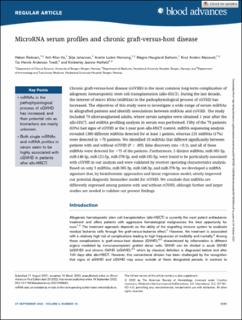| dc.contributor.author | Reikvam, Håkon | |
| dc.contributor.author | Vo, Anh Khoi | |
| dc.contributor.author | Johansen, Silje | |
| dc.contributor.author | Hemsing, Anette Lodvir | |
| dc.contributor.author | Haugland Solheim, Magne | |
| dc.contributor.author | Mosevoll, Knut Anders | |
| dc.contributor.author | Tvedt, Tor Henrik Anderson | |
| dc.contributor.author | Hatfield, Kimberley Joanne | |
| dc.date.accessioned | 2022-10-27T12:44:29Z | |
| dc.date.available | 2022-10-27T12:44:29Z | |
| dc.date.created | 2022-10-22T12:33:04Z | |
| dc.date.issued | 2022 | |
| dc.identifier.issn | 2473-9529 | |
| dc.identifier.uri | https://hdl.handle.net/11250/3028672 | |
| dc.description.abstract | Chronic graft-versus-host disease (cGVHD) is the most common long-term complication of allogeneic hematopoietic stem cell transplantation (allo-HSCT). During the last decade, the interest of micro RNAs (miRNAs) in the pathophysiological process of cGVHD has increased. The objectives of this study were to investigate a wide range of serum miRNAs in allografted patients and identify associations between miRNAs and cGVHD. The study included 79 allotransplanted adults, where serum samples were obtained 1 year after the allo-HSCT, and miRNA profiling analysis in serum was performed. Fifty of the 79 patients (63%) had signs of cGVHD at the 1-year post–allo-HSCT control. miRNA sequencing analysis revealed 1380 different miRNAs detected for at least 1 patient, whereas 233 miRNAs (17%) were detected in >70 patients. We identified 10 miRNAs that differed significantly between patients with and without cGVHD (P < .005; false discovery rate <0.1), and all of these miRNAs were detected for >75 of the patients. Furthermore, 5 distinct miRNAs, miR-365-3p, miR-148-3p, miR-122-5p, miR-378-3p, and miR-192-5p, were found to be particularly associated with cGVHD in our analysis and were validated by receiver operating characteristics analysis. Based on only 3 miRNAs, miR-365-3p, miR-148-3p, and miR-378-3p, we developed a miRNA signature that, by bioinformatic approaches and linear regression model, utterly improved our potential diagnostic biomarker model for cGVHD. We conclude that miRNAs are differently expressed among patients with and without cGVHD, although further and larger studies are needed to validate our present findings. | en_US |
| dc.language.iso | eng | en_US |
| dc.publisher | American Society of Hematology | en_US |
| dc.rights | Attribution-NonCommercial-NoDerivatives 4.0 Internasjonal | * |
| dc.rights.uri | http://creativecommons.org/licenses/by-nc-nd/4.0/deed.no | * |
| dc.title | MicroRNA serum profiles and chronic graft-versus-host disease | en_US |
| dc.type | Journal article | en_US |
| dc.type | Peer reviewed | en_US |
| dc.description.version | publishedVersion | en_US |
| dc.rights.holder | Copyright 2022 The American Society of Hematology | en_US |
| cristin.ispublished | true | |
| cristin.fulltext | original | |
| cristin.qualitycode | 1 | |
| dc.identifier.doi | 10.1182/bloodadvances.2021005930 | |
| dc.identifier.cristin | 2063947 | |
| dc.source.journal | Blood Advances | en_US |
| dc.source.pagenumber | 5295-5306 | en_US |
| dc.identifier.citation | Blood Advances. 2022, 6 (18), 5295-5306. | en_US |
| dc.source.volume | 6 | en_US |
| dc.source.issue | 18 | en_US |

